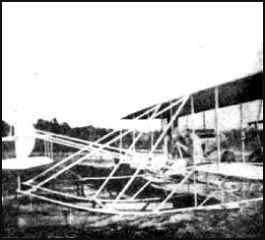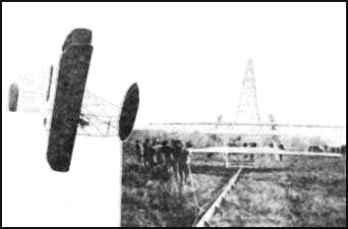But, back in 1909, just before Richmonders witness their first "hop," Hubert Fathom, then one of
the world's premier flyers, had established the world's altitude record of 580 feet, and Wilder Wright made a record-breaking round trip up
the Hudson River from Governor's Island to Grant's tomb and return.
The next year, 1910, local aviation enthusiasts had an opportunity to view a different make of
aeroplane, one built by the Wright brothers. A great controversy was raging between Messrs. Wright and Curtiss over the question of
patent infringements, the Wrights having patent rights to the wing-warping method of providing lateral stability and Mr. Curtiss maintaining
that his method of placing a movable eareolon between the wings did not encroach on their rights. The reporter for the Times-Dispatch
seems to have sided with the Wrights, for his stories covering the flights at the 1910 Fair certainly contain some unkind comparisons,
favoring the Wright brothers model.
The aviator in 1910 was the well-known Ralph Johnstone, who had
contracted "to fly for at least 10 minutes every day" during the fair week. Mr. Johnstone's publicity man is quoted as having said that the
flyer would do more than his contract required and "will probably cut figure eights, the pigeon wing, and chase the sparrows to their
nests. Johnstone must have lived up to his advance notices, although to this day I have never seen any one "cut a pigeon's wing.
"Except in an old-fashioned square dance. However, the newspaper account of his flight on the first day declares "people who
witnessed the feat came away puzzled whether or not to believe their own eye."
The Wright plane of that day was, indeed, an odd-looking affair, compared to later ones. It had no
inclosed body; the tail surfaces were supported by bamboo stringers which extended back from the wings. The two propellors turned in
opposite directions, and were operated by one motor. There was no cockpit; the aviator simply sat in a bucket seat placed in front of the
engine. All manipulating was done by hand; the foot control for the rudder had not yet been adopted. The elevator was in front of the
place and instead of landing wheels, there were skids. The takeoff was made from a monorail placed along the ground. But the plane
flew, and Johnstone's exhibition was a thing of joy. "Johnstone was absolutely careless of the laws of gravitation. He sprang upward and
swooped downward. He rose to the dizzy height of a thousand feet..." and on and on.
Among Johnstone's many admirers was Richmond's foremost air-minded citizen, the Hon. Dave
Richardson, then Mayor and later judge. Mayor Richardson declared, after watching Johnstone in flight, that he would like to go up with
him, and after Tuesday's exhibition, concluded arrangements to fly with Johnstone the next afternoon, which even 30 and more years
ago was Richmond Day. The Mayor was very much worried that his weight would bar him, as he was 30 pounds over the accepted limit.
However, Mr. Johnstone agreed to take him up, and after the contract flight on Wednesday afternoon, the plane was again placed on
the monorail for the first passenger flight in Richmond's aerial history.
Mayor Richardson took his seat beside the pilot, was strapped in tightly around the waist and
shoulders, and warned not to touch any part of the machine. With a roar and a cloud of dust, they were off down the rail. After a run of
about 200 feet, Johnstone lifted the plane into the air. The Mayor could be seen smiling broadly. The 60,000 people assembled broke
into a great cheer. The Mayor waved his hand in response. In doing so, he accidentally struck the cord which disconnected the ignition.
The motor immediately went dead at an altitude of 50 feet!
The plane had sufficient momentum to continue forward a bit before it began gliding to earth, and
about 10 feet off the ground lost all momentum and fell like a stone. Very fortunately, neither the Mayor nor Mr. Johnstone were injured,
but the plane was quite badly wrecked, and was not repaired in time to make a flight on Thursday, despite the heroic efforts of Mr.
Johnstone and his crew and several local carpenters. Although it was ready on Friday, no flight was made because of rain.
On Saturday, the plane, with Mr. Johnstone at the controls, was scheduled to race an automobile for
five miles, but the rain continued and the race was called off. However, on that day Johnstone made his farewell flight, in the rain, and
this was terminated suddenly when the same cord which had caused the Mayor's mishap shrunk from the wetness to such an extent that
the motor was again stopped in midflight.
The next year, 1911, 17-year-old Howard Levan, with a Curtiss plane, was the attraction, but his
performances were not up to Johnstone's standards. He, too, suffered from an accident on Richmond Day, when the propellor on his
machine was broken, but he secured another one from Washington and flew again on Friday. No flight was made on Saturday,
because "there was too much wind." Mr. Levan's flights were in opposition to those in a dirigible operated by Professor Hutcheson, from
which parachute jumps were made by George Sewell. Sewell stole the whole air exhibit, using as many as six chutes in his multiple
jumps.
In 1912 and 1914, there were no heavier-than-air planes at the fair, Professor Hutcheson and his
jumpers having the air to themselves. In 1913, an Italian flyer named Peola gave exhibitions with a Curtiss biplane, but the newspaper
accounts of these flights were not at all glowing or extensive.
In 1915, however, Richmonders were given their final initiation into the art of flying through the
exhibitions of a young daredevil by the name of Art Smith. Aviator Smith was Richmond's first stunt pilot, and, although he received a
terrific buildup, he warranted it and pleased his public no end. The reporter for the Times-Dispatch went overboard for him, based on the
following excepts from his stories:
"The first real sensation came when Art Smith, aviator, soaring in his aeroplane at a height of about
1,000 feet over the northwestern section of the race track, seemingly lost control of his machine. The aeroplane, which in the preceding
quarter of an hour had skimmed and curved its way as easily and gracefully as a humming bird on the wing, suddenly halted abruptly in
the air and threw a somersault. Hundreds of those among the spectators a thousand feet below joined in a gasp of horror. Another gasp
went up a minute later when it was seen the plane was righting itself and the daring aviator was in his seat. This time, it was a gasp of
relief. The next minute, Smith was steering far another loop, and it became apparent to the bewildered throng below that the first quick
loop was not accidental. Amazement grew in the succeeding five minutes, which the daredevil airman devoted to putting his craft
through a series of somersaults. He described in the air the orbit known as the loop nine consecutive times without entirely righting his
machine." And that night, Art Smith made more aviation history for Richmond when he gave the first after-dark exhibition.
Let the Times-Dispatch reporter of that day again tell you about it. "With bated breath and tense with
excitement, thousands of fairgoers last night witnessed the most daring aerial flight ever seen in Richmond, when Art Smith, daredevil
aviator, shot, meteorlike, through the air and executed the thrilling evolutions that have made him famous as a birdman the world over.
Rising slowly from the far end of the race track to the south of the grand stand, the aeroplane glided easily and gracefully into space,
starting on its flight northward after sailing several hundred feet into the air. Intermittent streams of fire blazed out from the rear of the
machine as it sped along its course. After circling the race track twice, the flames became continuous, and, comet-like, the machine
blazed its way into space. Then the thrilling evolutions began. First swooping downward, as if to come to earth, the daring aviator
regained his equilibrium and proceeded to 'loop the loop.' Following up this sensational flight, Art Smith executed the 'side roll,' flew
upside down and did all kinds of stunts that made the man in the grand stand hold his breath and wonder what was coming next.
Smith made flights and performed stunts on the next two days and nights of the fair, and the reported
story includes the following:
"Among the feats he performed were flying his plane wing over wing, executing the side roll, flying the
plane tail first, throwing the back flop, looping the loop, and, finally, describing in a vertical descent an almost perfect spiral."
Smith was followed for the last three days of that year's fair by Baxter Adams. This flyer staged a
five-mile race between plane and motorcycle which was won by the latter because of the time and distance the plane required to make
its turns.
Three years later, I myself was thoroughly trained in aerial acrobatics by United States Army
instructors, and I have been flying intermittently for the past 20 years. Now, while I would not dim the glory of pioneer Art Smith, nor
question the integrity of a Times-Dispatch reporter, nevertheless, I must admit I cannot understand the maneuver called the back flop,
and I have never seen any one fly a plane tail first. Perhaps the reporter, in crediting Smith with flying backwards, had a 23-year advance
knowledge of the feat which made Corrigan famous.
Within another year, aviation had taken such strides that Richmond no longer had to wait for the fair in
order to enjoy air thrills. Between the war in Europe and the naturally rapid advancement of aeronautics. Richmond's papers were full of
air new, and Richmond's skies were full of planes. The proximity of Langley Field and later the establishment of two local airports have
kept the city in close touch with every step in the forward march of the men with wings.
But, when the last super-super in airplane construction has been built, Richmonders can look back to
1909 and rightfully say, "Well, this new plane is some machine, but I can remember back yonder when--"
URL: http://www.thenandnow.bravepages.com/AirShow1909.html
Email: A. C. Griffith |



